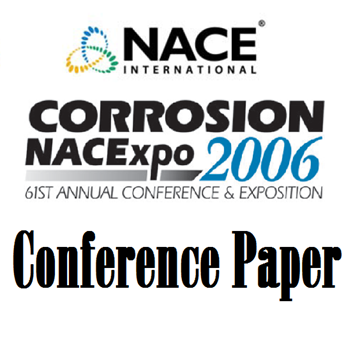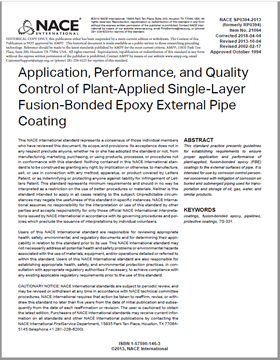
Available for download
Product Number:
51300-06057-SG
ISBN:
06057 2006 CP
Author:
Ali N Moosavi, Salim Al-Mutawa, Salah Balboul and Mostafa Saady
Publication Date:
2006
$20.00
We're sorry, something went wrong.
We are unable to complete this action. Please try again at a later time.
If this error continues to occur, please contact AMPP Customer Support for assistance.
Error Message:
Please login to use Standards Credits*
* AMPP Members receive Standards Credits in order to redeem eligible Standards and Reports in the Store
You are not a Member.
AMPP Members enjoy many benefits, including Standards Credits which can be used to redeem eligible Standards and Reports in the Store.
You can visit the Membership Page to learn about the benefits of membership.
You have previously purchased this item.
Go to Downloadable Products in your AMPP Store profile to find this item.
You do not have sufficient Standards Credits to claim this item.
Click on 'ADD TO CART' to purchase this item.
Please review your transaction.
Click on 'REDEEM' to use your Standards Credits to claim this item.
You have successfully redeemed:
Go to Downloadable Products in your AMPP Store Profile to find and download this item.

Available for download
Product Number:
MPWT19-14360
Author:
Rashed Alhajri, Yousef Alrayes, Fahad Alhindas, Ghassan Bahamden
Publication Date:
2019
$0.00
During the construction of a 56km long 16 in. carbon steel sour gas pipeline, repetitive surface
preparation failures were detected during visual inspection of pipeline girth weld internal surface prior to
coating application. Such failures represented 67% of the total pipeline girth welds and were manifested
by excessive sharp-edges at the root pass. To identify the failure causes, an investigation was
performed through reviewing the pipeline, fabrication and coating application specifications and
procedures, quality control records and performing an extensive visual inspection through an advanced
video robotic crawler on all pipeline girth welds made. Upon investigation analysis, the failures were
caused by sharp-edges in the root pass which were attributed to improper practices during
manufacturing, field fabrication and pre-coating quality control. The failure analysis indicated that the
mechanized Gas Metal Arc Welding process, with the parameters used, was not suitable for internal
girth weld coating application. In addition, a more stringent requirement should be applied to the
acceptable pipe-end diameter tolerance and pre-coating quality control to ensure absence of similar
premature surface preparation failures. The pre-coating quality control can be improved through
utilization of robotic laser contour mapping crawler for precise detection and sizing of unsatisfactory
surface weldment defects, including sharp edges.
We're sorry, something went wrong.
We are unable to complete this action. Please try again at a later time.
If this error continues to occur, please contact AMPP Customer Support for assistance.
Error Message:
Please login to use Standards Credits*
* AMPP Members receive Standards Credits in order to redeem eligible Standards and Reports in the Store
You are not a Member.
AMPP Members enjoy many benefits, including Standards Credits which can be used to redeem eligible Standards and Reports in the Store.
You can visit the Membership Page to learn about the benefits of membership.
You have previously purchased this item.
Go to Downloadable Products in your AMPP Store profile to find this item.
You do not have sufficient Standards Credits to claim this item.
Click on 'ADD TO CART' to purchase this item.
Please review your transaction.
Click on 'REDEEM' to use your Standards Credits to claim this item.
You have successfully redeemed:
Go to Downloadable Products in your AMPP Store Profile to find and download this item.

Available for download
Product Number:
51321-16808-SG
Author:
Facundo Varela; Mauricio Latino; Yongjun Tan; Maria Forsyth
Publication Date:
2021
$20.00
We're sorry, something went wrong.
We are unable to complete this action. Please try again at a later time.
If this error continues to occur, please contact AMPP Customer Support for assistance.
Error Message:
Please login to use Standards Credits*
* AMPP Members receive Standards Credits in order to redeem eligible Standards and Reports in the Store
You are not a Member.
AMPP Members enjoy many benefits, including Standards Credits which can be used to redeem eligible Standards and Reports in the Store.
You can visit the Membership Page to learn about the benefits of membership.
You have previously purchased this item.
Go to Downloadable Products in your AMPP Store profile to find this item.
You do not have sufficient Standards Credits to claim this item.
Click on 'ADD TO CART' to purchase this item.
Please review your transaction.
Click on 'REDEEM' to use your Standards Credits to claim this item.
You have successfully redeemed:
Go to Downloadable Products in your AMPP Store Profile to find and download this item.

Available for download
Product Number:
21064-SG
Publication Date:
2013
$179.00
We're sorry, something went wrong.
We are unable to complete this action. Please try again at a later time.
If this error continues to occur, please contact AMPP Customer Support for assistance.
Error Message:
Please login to use Standards Credits*
* AMPP Members receive Standards Credits in order to redeem eligible Standards and Reports in the Store
You are not a Member.
AMPP Members enjoy many benefits, including Standards Credits which can be used to redeem eligible Standards and Reports in the Store.
You can visit the Membership Page to learn about the benefits of membership.
You have previously purchased this item.
Go to Downloadable Products in your AMPP Store profile to find this item.
You do not have sufficient Standards Credits to claim this item.
Click on 'ADD TO CART' to purchase this item.
Please review your transaction.
Click on 'REDEEM' to use your Standards Credits to claim this item.
You have successfully redeemed:
Go to Downloadable Products in your AMPP Store Profile to find and download this item.




